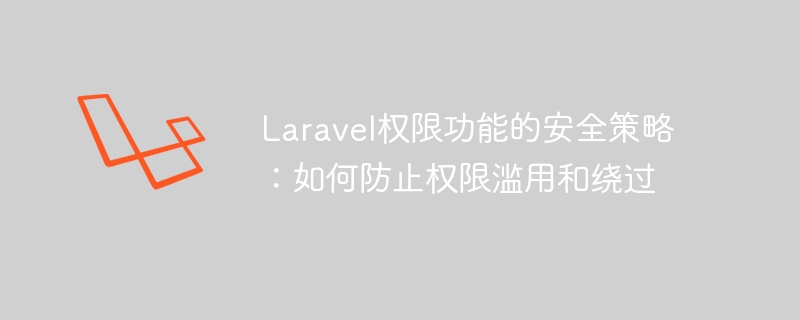

Laravel is a modern PHP framework with very powerful permission management and authentication functions. However, if appropriate security strategies are not adopted, there are still security issues such as permission management abuse and bypass. This article will introduce some security strategies when using Laravel's permission functions and provide specific code examples.
1. Abuse of permission management
Abuse of permission management refers to the excessive use of authorized users' permissions, such as authorizing employees in the human resources department to operate, deleting bills from the financial department, etc. Such abuse may lead to leakage of confidential information, data loss and other adverse consequences. In order to prevent this situation, we can add two security policies to Laravel.
1. Permission approval system
The permission approval system can limit the use of user permissions. For example, administrators can only operate sensitive data after approval. The code example to implement this strategy is as follows:
public function update(Request $request, $id)
{
$user = User::find($id);
if (!$user->hasPermission('edit_user')) {
abort(403, '你没有权限修改用户信息。');
}
// 判断该用户是否需要审批
if ($user->needApproval()) {
// 如果需要审批,则需要审批人进行审核通过后才能修改用户
$approver = $user->approver;
if (!$approver->hasPermission('approve_user')) {
abort(403, '你没有权限审批用户信息修改请求。');
}
$user->name = $request->name;
$user->email = $request->email;
$user->save();
return redirect()->route('users.show', $user->id)->with('success', '用户信息修改成功!');
}
// 如果不需要审批,则直接修改用户
$user->name = $request->name;
$user->email = $request->email;
$user->save();
return redirect()->route('users.show', $user->id)->with('success', '用户信息修改成功!');
}In the above code, we use the two methods hasPermission() and needApproval() to determine whether the user Have modification permissions and whether approval is required. If approval is required, verify whether the approver has approval authority. If the above conditions are met, user information can be modified.
2. Frequency Limitation
Frequency limitation can prevent malicious users from repeatedly performing certain operations in a short period of time, such as logging in, registering, etc. This prevents attackers from using brute force tools to crack passwords or create large numbers of fake accounts. Laravel provides ThrottleRequests middleware, we can add the following code in the appHttpKernel.php file:
protected $middlewareGroups = [
'web' => [
AppHttpMiddlewareEncryptCookies::class,
IlluminateCookieMiddlewareAddQueuedCookiesToResponse::class,
IlluminateSessionMiddlewareStartSession::class,
// 加入ThrottleRequests中间件
IlluminateRoutingMiddlewareThrottleRequests::class,
IlluminateContractsAuthMiddlewareAuthenticate::class,
IlluminateRoutingMiddlewareSubstituteBindings::class,
],
'api' => [
'throttle:60,1',
'auth:api',
],
];In the above code, 'throttle:60 ,1' means that a maximum of 60 executions per minute are allowed. If the user attempts to perform an action multiple times within a short period of time, an HTTP 429 error will be returned.
2. Permission management bypass
Permission management bypass means that unauthorized users or attackers use vulnerabilities to gain control of the system. This may lead to system instability, data leakage and other issues. In order to prevent permission management bypass, we can add the following two security policies to Laravel.
1. Data filtering
In Laravel, we can define data filters in the model to limit query results. Using data filtering can prevent attackers from injecting SQL code in the URL or obtaining unauthorized data. The following code example demonstrates how to use data filtering.
class MyModel extends Model
{
// 只查询被授权的数据
public function scopeAuthorized($query)
{
// 获取当前用户的权限数组
$permissions = auth()->user()->permissions->pluck('name')->toArray();
// 过滤只保留当前用户有权限的数据
return $query->whereIn('permission', $permissions);
}
}In the above code, the scopeAuthorized() method uses the whereIn() method to avoid querying unauthorized data. The pluck() method returns an IlluminateSupportCollection instance, which is converted into a PHP array through the toArray() method.
2. Force the requester to authenticate
Use middleware auth to force the requester to authenticate. In our controller, we can use the auth middleware like this:
public function __construct()
{
$this->middleware('auth');
}If the requester is not authenticated, the request will be rejected. We can save a lot of code that we need to write when using other solutions, because Laravel handles all the authentication related details directly.
Summary
In Laravel, the permission management and authentication functions are very powerful. However, we still need to adopt some security strategies when facing malicious users and hackers. This article provides some long-proven security strategies, along with specific code examples. Hope this article can help you improve the security of Laravel.
The above is the detailed content of Security Strategy for Laravel Permissions Features: How to Prevent Permission Abuse and Bypass. For more information, please follow other related articles on the PHP Chinese website!




